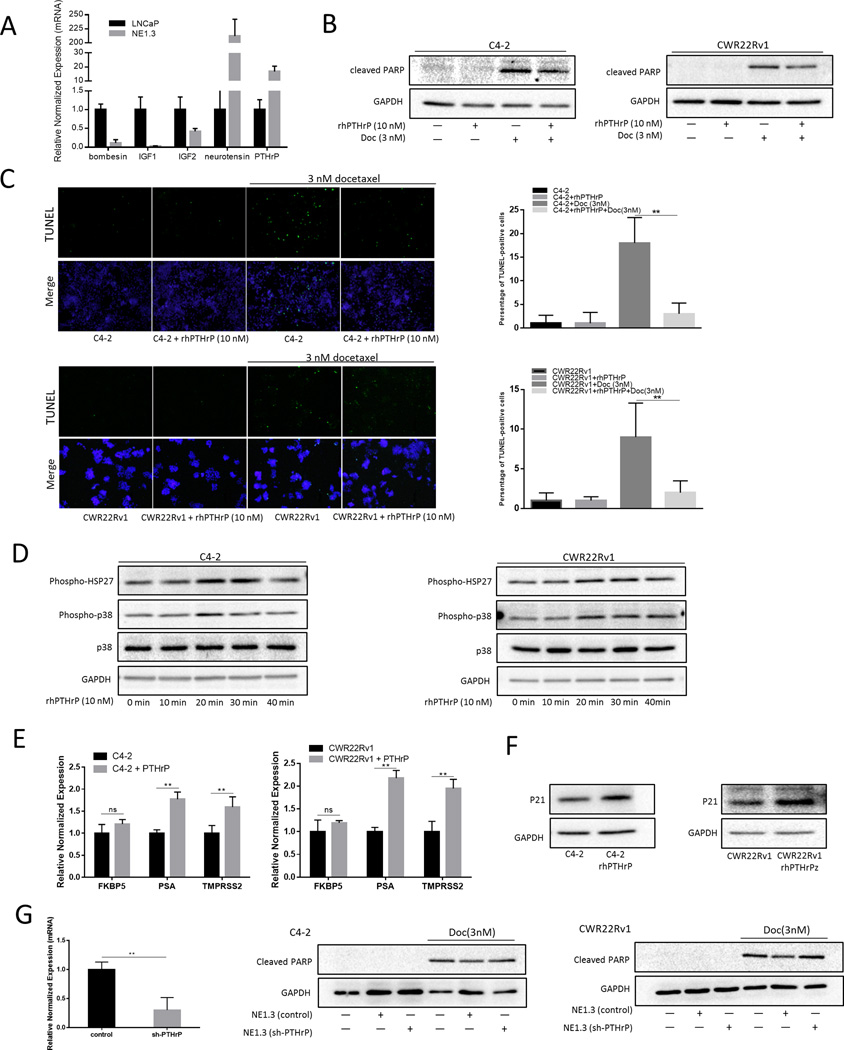Figure 5.
Neuroendocrine peptide PTHrP can protect PCa from docetaxel (Doc)-induced apoptosis. A. PTHrP is upregulated in NE1.3 cells have a higher expression of PTHrP compared to parental LNCaP cells. Total RNA were analyzed by Q-PCR to show neuroendocrine-related cytokines and peptides, including bombesin, IGF1, IGF2, PTHrP, and neurotensin. B–C. PTHrP protects PCa from Doc induced apoptosis. C4-2 and CWR22Rv1 cells were treated with or without recombinant human (rh)-PTHrP (10 nM) for 24 hours. Western blot analysis (B) of the expression of cleaved PARP after treating with 3 nM Doc for 48 hours. TUNEL assay analysis (C) of cell apoptosis after treating with or without 3 nM Doc for 48 hours and the right panels are the quantitative data for TUNEL. D. PTHrP phosphorylates p38 kinase and Hsp27 in a time-dependent manner (with maximum at 20 min). C4-2 and CWR22Rv1 cells were serum starved for 24 hours, then treated with rhPTHrP (10 nM) for different times (0 min, 10 min, 20 min, 30 min and 40 min). Total proteins were analyzed by Western blotting as shown using anti–phospho-p38 and anti–phospho-Hsp27 antibodies. E. PTHrP increased AR activity of C4-2 and CWR22Rv1 cells. C4-2 (left panel) and CWR22Rv1 (right panel) cells were treated with or without rh-PTHrP (10 nM) for 12 hours. Total RNA were analyzed by Q-PCR to show AR regulated gene, FKBP5, PSA and TMPRSS2. F. PTHrP upregulates p21 in PCa. C4-2 and CWR22Rv1 cells were serum starved for 24 hours, then treated with rhPTHrP (10 nM) for 48 hours, western blot analysis of the expression of p21 in C4-2 (left panel) and CWR22Rv1 (right panel) cells. G. Knocking down PTHrP partially reversed the NEPC-increased neighboring PCa chemo-resistance. C4-2 and CWR22Rv1 cells were cultured with/without NE1.3 cells with knocked down PTHrP (sh-PTHrP) for 72 hours and western blot analysis of the expression of cleaved PARP after treating with 3 nM Doc for 48 hours. **p < 0.01 and ns, no statistical difference.

